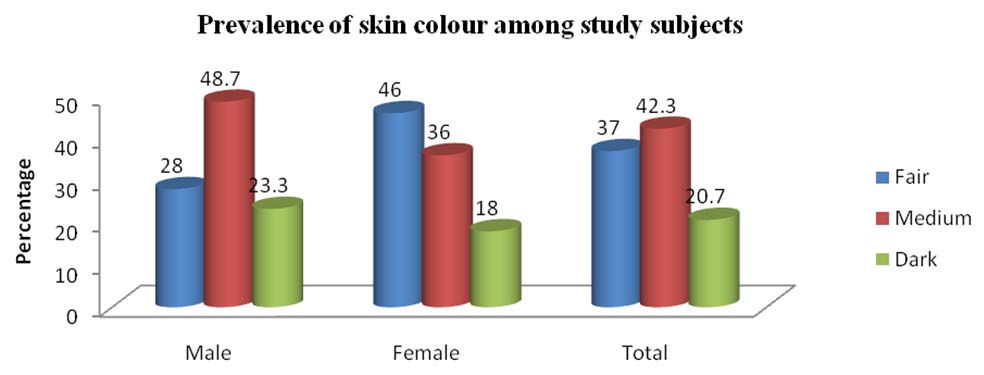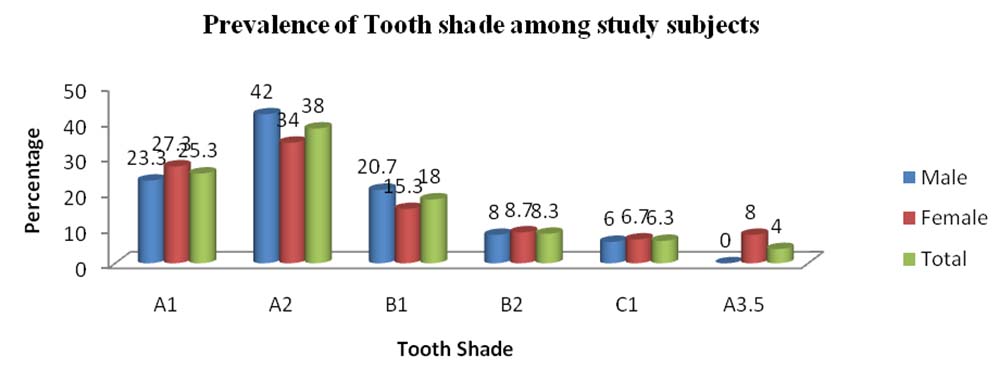Aesthetics has become an important issue in modern society, as it seems to define one’s character. In the past, functional demands were the main consideration in dental treatment. Today, with the decrease in caries prevalence, the focus has shifted toward dental aesthetics [1].
Shade selection is an important procedure to provide patients with an aesthetic restoration that harmoniously blends to the patient’s existing dentition. Natural teeth are known to possess different shades in their surfaces [2]. Moreover, it has been found that the colour of natural teeth is influenced by many factors. Age is the commonest of these. Light is perhaps one of the most important factors [3] and unfortunately also the most commonly overlooked one. Also, colour imparted by different skin complexions, is an another factor that may influence the shades of natural teeth [4,5].
The selection of teeth with a proper shade has been shown to positively influence the patient’s aesthetic perception and improved prosthesis acceptance [6]. The selection of artificial teeth to replace missing natural teeth is a relatively straight forward procedure when some of the natural anterior teeth remain. Various tooth shade guides have been developed through the last century [7] but these have been essentially useful in patients with natural teeth. However, for the edentulous individual, with no pre-extraction records available, the choice of tooth shade is problematic.
Various factors such as age, sex and skin colour have been proposed as an aid for artificial tooth shade selection [7]. Some dentists have suggested colour of hair, eye colour but most authors favour the use of facial skin tone as a guide to tooth shade selection [8].
The selection of artificial teeth colour can be very tasking and denture aesthetics has been defined as “The cosmetic effect produced by a dental prosthesis which affects the desirable beauty, attractiveness, character and dignity of the individual [9].
There is limited scientific information on relationship between facial skin complexion and tooth colour in Indian population. This lack of knowledge may impact the ability of prosthodontist to provide better aesthetics to the patient. The purpose of this study was to assess prevalence of tooth shade and facial skin colour among chitradurga population and to correlate the tooth shade with facial skin colour.
Materials and Methods
A total number of 300 subjects in the age group 18-20 years were considered for the study. The subjects in the present study were recruited from pre university colleges in Chitradurga city. The ethical approval for the study was obtained from the Institutional Ethical Committee of SJM dental college and hospital, Chitradurga, Karnataka. Informed consent was obtained from the all recruited students.
Sample size was calculated by using the formula

Where
n = sample size
N = population size
e = desired level of precision.
A total of approximately 3000 school children aged 18-20 years were studying in chitradurga city. By considering total population a minimum sample size required was found to be 350.
Fifty subjects were considered for pilot study (excluded from main study) to check the feasibility and reliability. Intra examiner reliability was found to be good with kappa value of 0.82.
Two stage simple random sampling was done. In the first stage colleges were selected randomly and from each selected college required number of study subjects was selected randomly. Subjects were analysed for tooth shade and facial skin colour by a single examiner.
Subjects with all the anterior teeth having normal tooth contours and structures were considered for inclusion. Those with smoking habits, tobacco chewing habits, suffering from systemic diseases affecting gingival colour and skin complexion, wearing any artificial facial make up and with extrinsic or intrinsic stains were excluded.
The facial skin complexion was divided into 3 categories: fair, medium and dark with the use of Lakme liquid foundation make up as a shade guide. The liquid foundation is available in five shades – “pearl”, “marble”, “shell”, “coral” and “rosewood”. The subjects having skin “pearl” and “marble” shade were grouped as fair. The subjects corresponding to “shell” and ‘coral” shade were grouped as medium and those having “rosewood” shade were under dark category.
Vitapan Classical shade guide (Vident) is a gold standard in dentistry which was used in the present study. Vitapan Classical shade tabs are divided into four groups, with primary group division based on hue. Within the groups, tab arrangement is based on increasing chroma-the more chromatic tabs are marked with higher numbers. Group A consists of five tabs (A1, A2, A3, A3.5, A4); Groups B and C consist of four tabs each (B1, B2, B3, B4 and C1, C2, C3, C4, respectively); and Group D consists of three tabs (D2, D3, D4) [10]. A single examiner who has evaluated the skin colour matched the shades of tooth in a bright natural light according to manufacturer’s instructions.
The subjects were examined in daylight by a single examiner for facial skin colour and tooth colour.
Statistical Analysis
Descriptive statistics were computed by considering percentage of population with skin colour and tooth shade. Data was analysed using chi square test and spearman’s correlation. A p-value less than 0.05 was considered as statistically significant. All analysis was carried out using SPSS 17.
Results
Present study was conducted to investigate the relationship between tooth shades with skin colour in Chitradurga population, Karnataka, India. A total of 300 subjects belonging to age group 18-20, of equal sex distribution studying at different degree colleges were selected for the study.
[Table/Fig-1] shows distribution of study subjects the mean age among males was 19.08±0.87 and among females it was 19.12±0.86 which was statistically non significant.
Distribution of study subjects.
| Gender | Number | Mean Age | SD | p-value |
|---|
| Males | 150 | 19.08 | 0.87 | 0.644NS |
| Females | 150 | 19.12 | 0.86 |
NS-Not Significant
[Table/Fig-2&3] shows that the prevalence skin colour among study participants. Out of 300 participants, 111 (37.00) had fair skin colour, 127 (42.3) had medium skin colour and 62 (20.7) had dark skin colour. The skin colour among male and female participants was found to be statistically significant (p<0.000) with females having more percentage of fair skin colour than males.
Prevalence of skin colour among study subjects.
| Skin Colour | Male | Female | Total Percentage | Chi Square | p-value and significance |
|---|
| Fair | 42(28.0%) | 69(46.0%) | 111(37.0%) | 10.442 | 0.005S |
| Medium | 73(48.7%) | 54(36.0%) | 127(42.3%) |
| Dark | 35(23.3%) | 27(18.0%) | 62(20.7%) |
p<0.05, S – Significant
Prevalence of skin colour among study subjects.

[Table/Fig-4&5] shows the prevalence of tooth shade among study subjects. Out of 300 students, 72 (25.3) had A1 shade, 114 (38) had A2 shade, 54 (18) had B1 shade, 25 (8.3) had B2 shade, 19 (6.3) had A3.5 shade and 12 (4) had C1 shade. The tooth shade among male and female participants was found to be statistically significant (p<0.000) with females having more percentage of A1 (27.3%) shade and males A2 Shade (42%).
Prevalence of Tooth shade among study subjects.
| Tooth shade | Male | Female | Total | Chi-Square | p-value and Significance |
|---|
| A1 | 35(23.3%) | 41(27.3%) | 72(25.3%) | 15.015 | 0.010S |
| A2 | 63(42.0%) | 51(34.0%) | 114(38) |
| B1 | 31(20.7%) | 23(15.3%) | 54(18.0%) |
| B2 | 12(8.0 %) | 13(8.7%) | 25(8.3%) |
| A3.5 | 9(6.0%) | 10(6.7%) | 19(6.3%) |
| C1 | 0(0%) | 12(8.0%) | 12(4.0%) |
p<0.05, S – Significant
Prevalence of skin colour among study subjects Prevalence of Tooth shade among study subjects.

[Table/Fig-6] shows the correlation between tooth shade and skin colour value using Spearman’s Correlation. There was positive correlation which found to be statistically significant (0.491) indicating that fair skin colour subjects having lighter tooth shade.
Correlation between tooth shade and skin colour.
| Skin Colour | A1 | A2 | B1 | B2 | A3.5 | C1 | Rvalue | p-valueandsignificance |
|---|
| Fair | 58 (52.3%) | 33(29.7%) | 13(11.7%) | 7(6.3) | 0(0%) | 0(0%) | 0.491 | 0.000HS |
| Medium | 14(11%) | 59(46.5%) | 35(27.6%) | 10(7.9%) | 6(4.6%) | 3(2.4%) |
| Dark | 4(6.5%) | 22(35.5) | 6 (9.7%) | 8(12.9%) | 13 (21.0%) | 9 (4.5%) |
P<0.05, HS – Highly Significant.
Discussion
Teeth colour is influenced by the absorption and scattering of the light in the tooth structure, the shape and thickness of its hard tissues, tooth type or place in the dental arch, and the geometry of tooth surface and its reflectance [11–13].
Tooth colour is one of the important factors affecting aesthetics. Colour is complex, encompasses both subjective and objective phenomenon [14]. There is limited scientific information on the relationship between tooth shade and skin colour, hence the present study was conducted to investigate the prevalence of tooth shade in Chitradurga population and to evaluate its association with skin colour as this lack of knowledge may hinder the ability of the prosthodontist to select artificial teeth that complement the facial complexion of the patient.
In the present study the Vitapan Classical shade guide was selected because of its routine use by dental professionals. The tooth shades were matched in standardized and uniform conditions. The colour of the facial skin serves as basic guide to tooth shade. Specifically it is suggested that the value of the teeth must correspond to darkness or lightness of the facial skin tone [14].
In past various researches have been conducted on relationship of shade with skin colour [4,15–18]. There is limited scientific information on the relationship between tooth shade and skin colour with reference to Chitradurga population. Herekar M et al., conducted a study to know prevalence of tooth shade among Indian population and this study is of its first kind in Chitradurga population [19]. According to Herekar M et al., in Belgaum the most prevalent shade in the population was in the range of A2 and A3 [19]. In our study most prevalent tooth shade was A2 (38.00) followed by A1 (25.3). Few studies have mentioned that there is gender difference in tooth shade with females having lighter shades than males [20,21] Results are in contrast to our study where both genders had almost same prevalence of shades.
In our finding there is an association between skin colour and tooth shade. Persons with medium and dark skin were more likely to have teeth in high value (dark teeth) category than persons with fair skin (low value) colour. These results are in contrast to the findings of Jahangiri et al., who found inverse relationship between tooth shade and skin colour in their study on multiracial population [4]. Further the findings of the present study are in contrast to study by Temitope et al., where the authors did not find any association between tooth and skin colour [21].
Limitations
Many authors have suggested age, gender, race or ethnicity, eye colour, skin colour as an influencing factor in selecting teeth. Understanding the influence of factors such as age, gender and skin colour on selection of artificial teeth in completely edentulous patients with no pre-extraction records, presents a unique challenge to dentists all over the world. Further longitudinal studies must be conducted to assess the facial skin colour change as age advances. Also how tooth shade changes from young age to old age.
Conclusion
Within the limitations of this study, it may be appropriate to conclude that facial skin colour does significantly correlate with tooth colour and may be a reliable guide for artificial tooth colour selection in this environment.
NS-Not Significantp<0.05, S – Significantp<0.05, S – SignificantP<0.05, HS – Highly Significant.